Charles E W Bean, Diaries, AWM38 3DRL 606/273/1 - 1918 - 1937 - Part 23

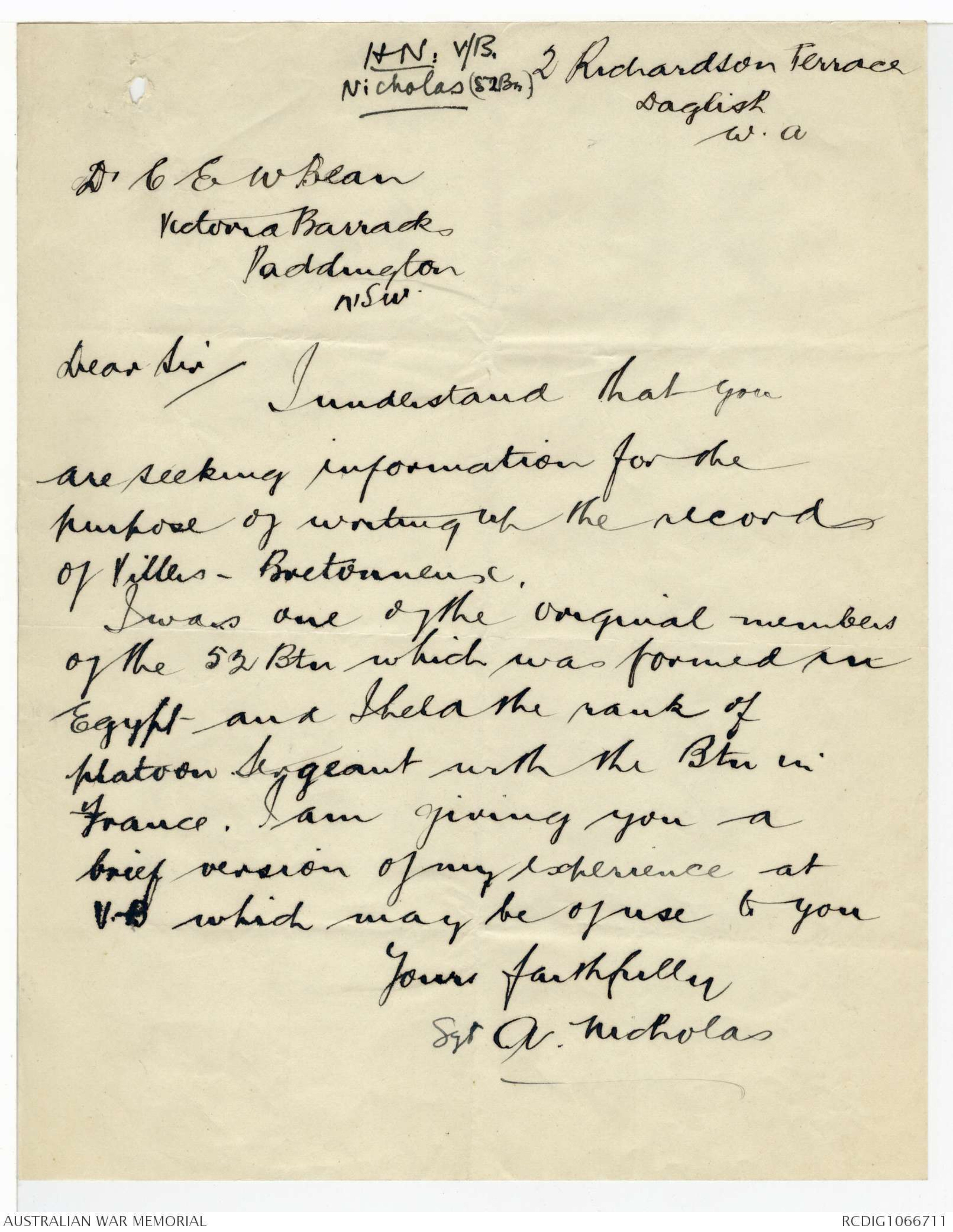
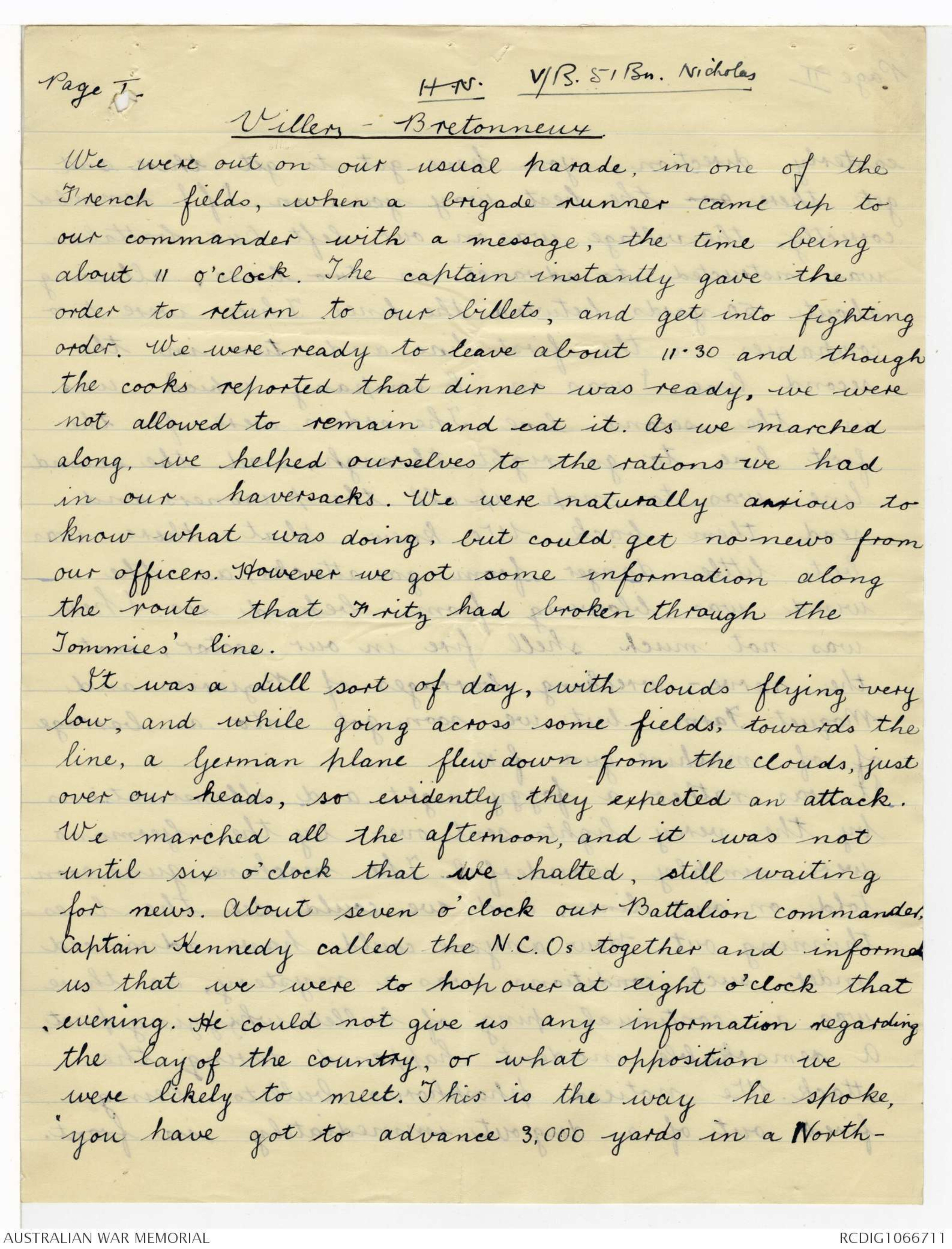


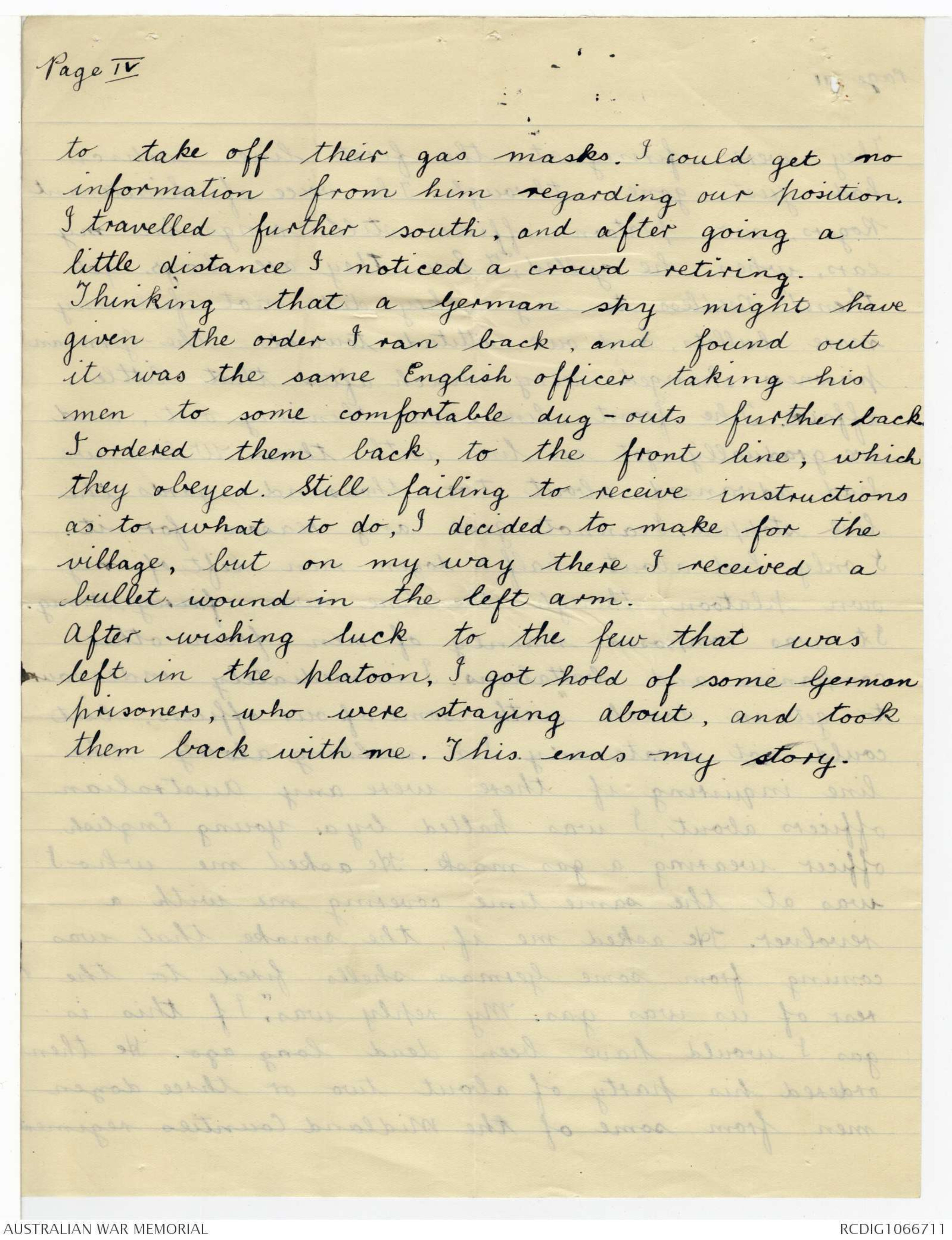
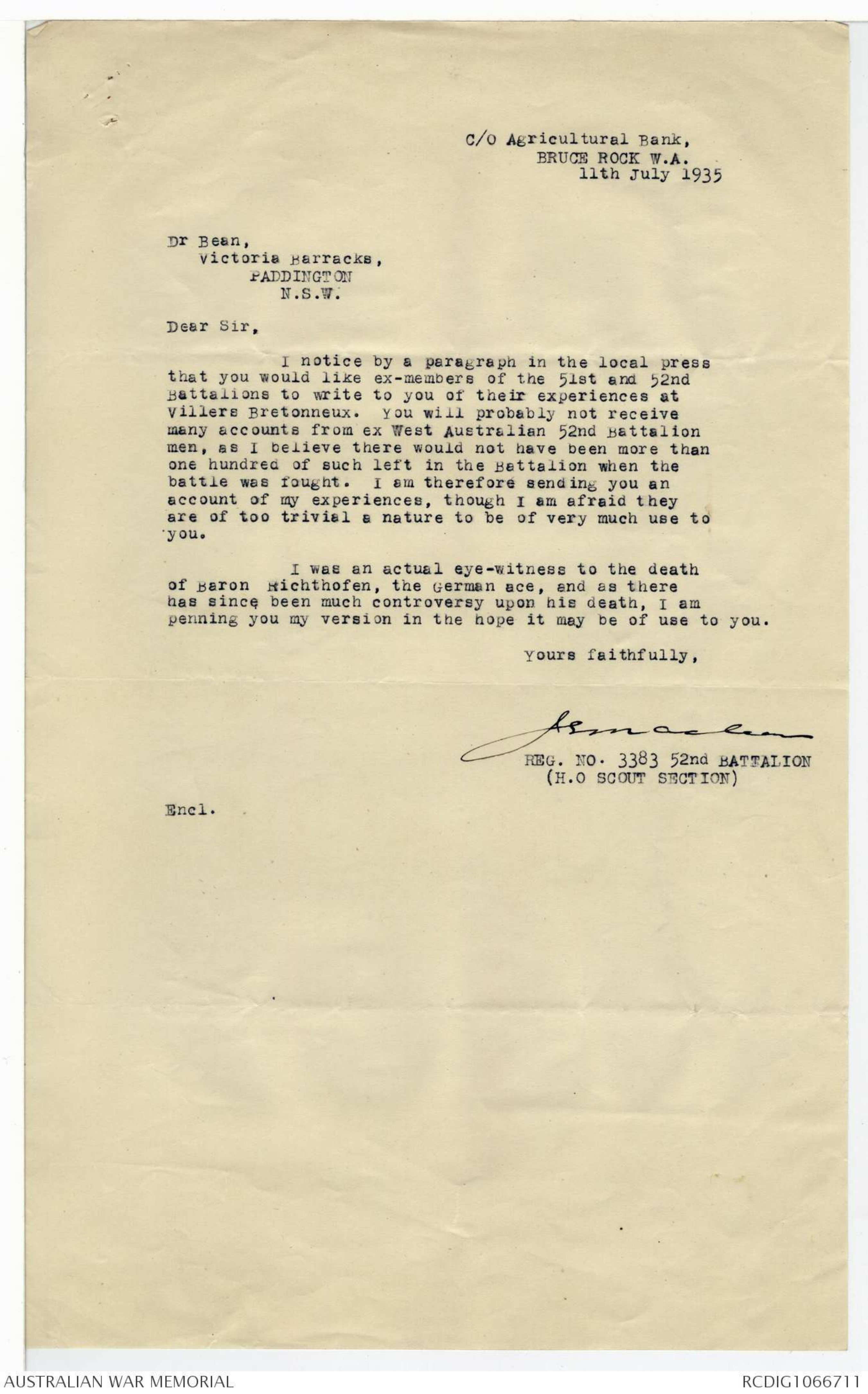
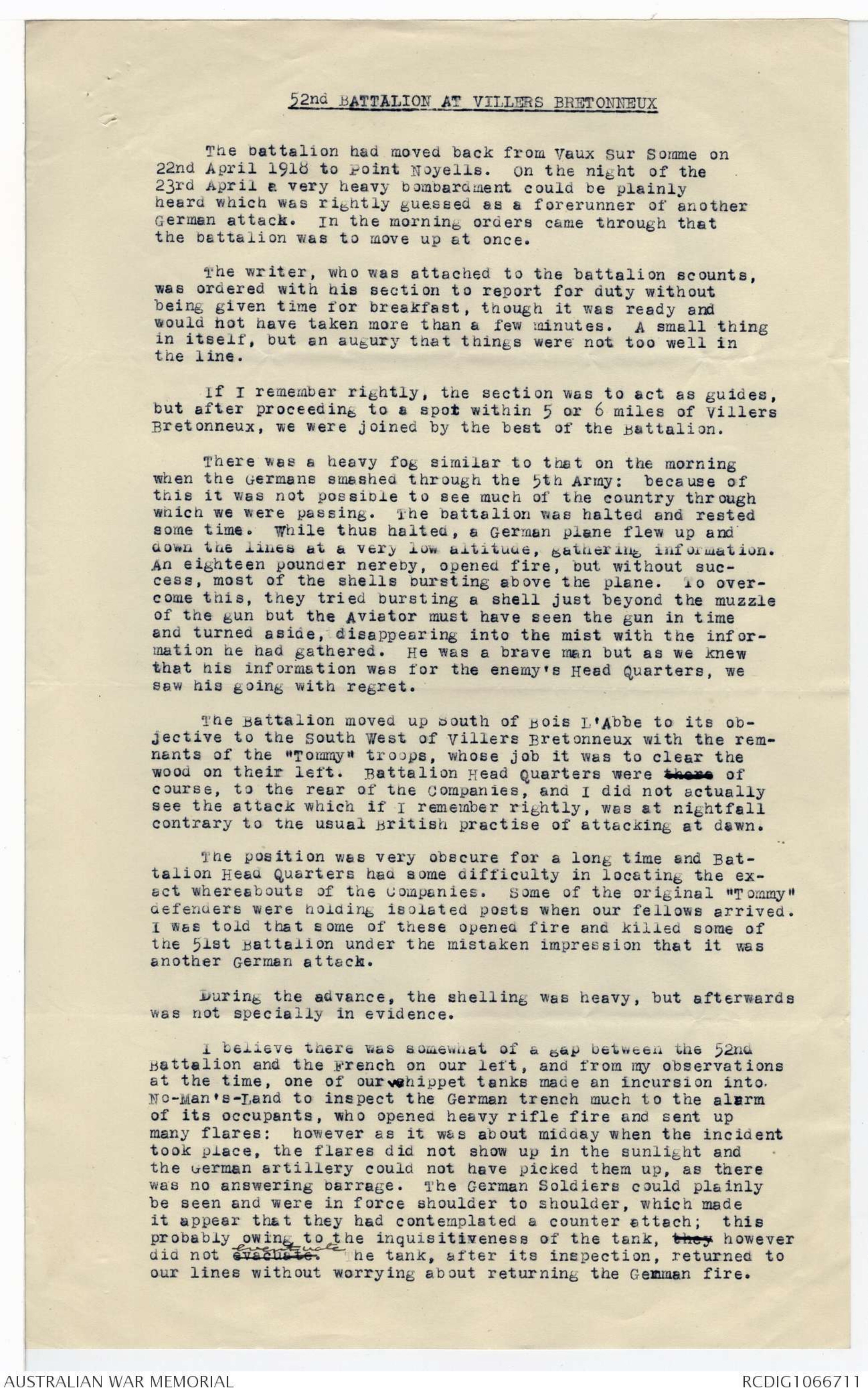
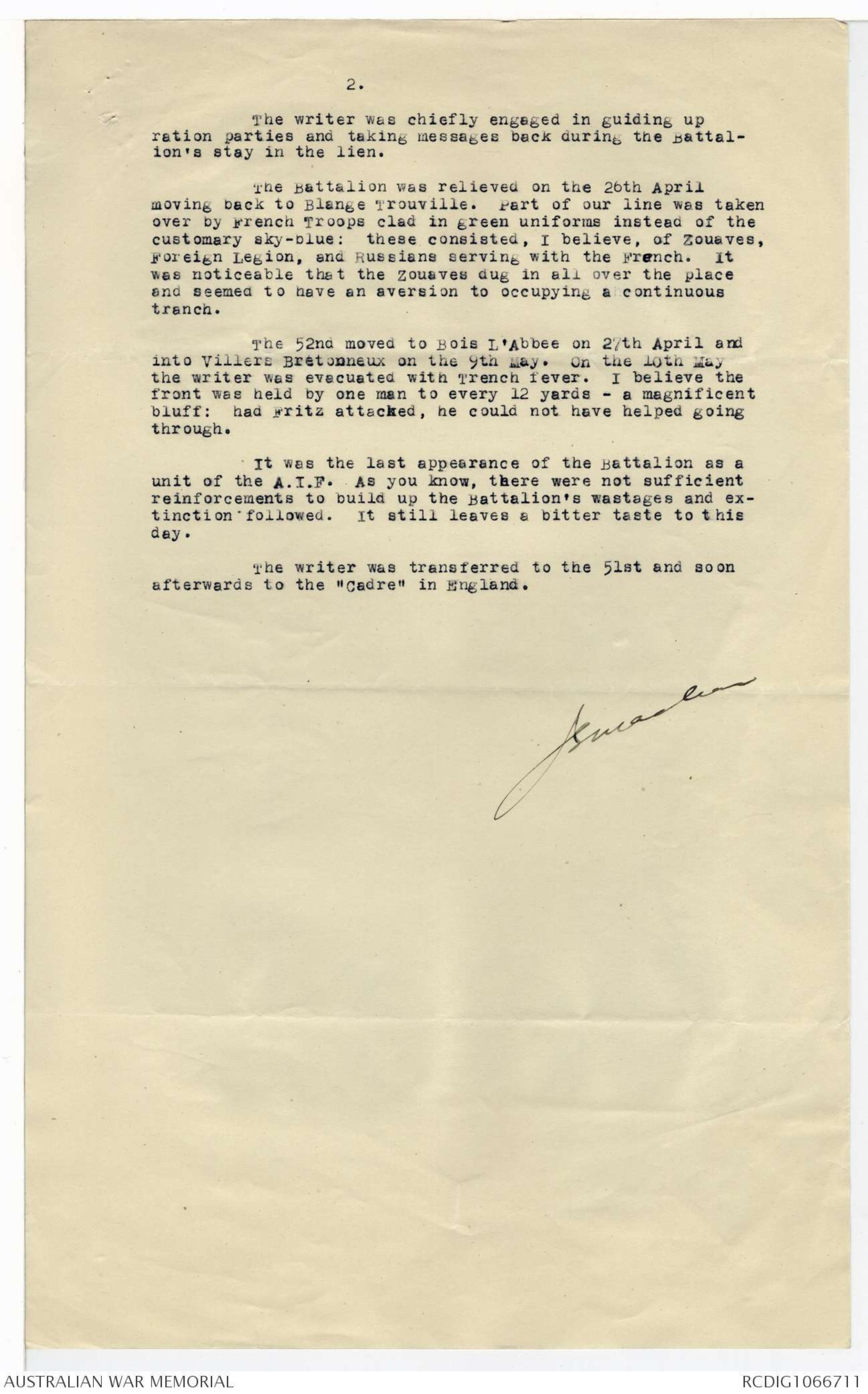
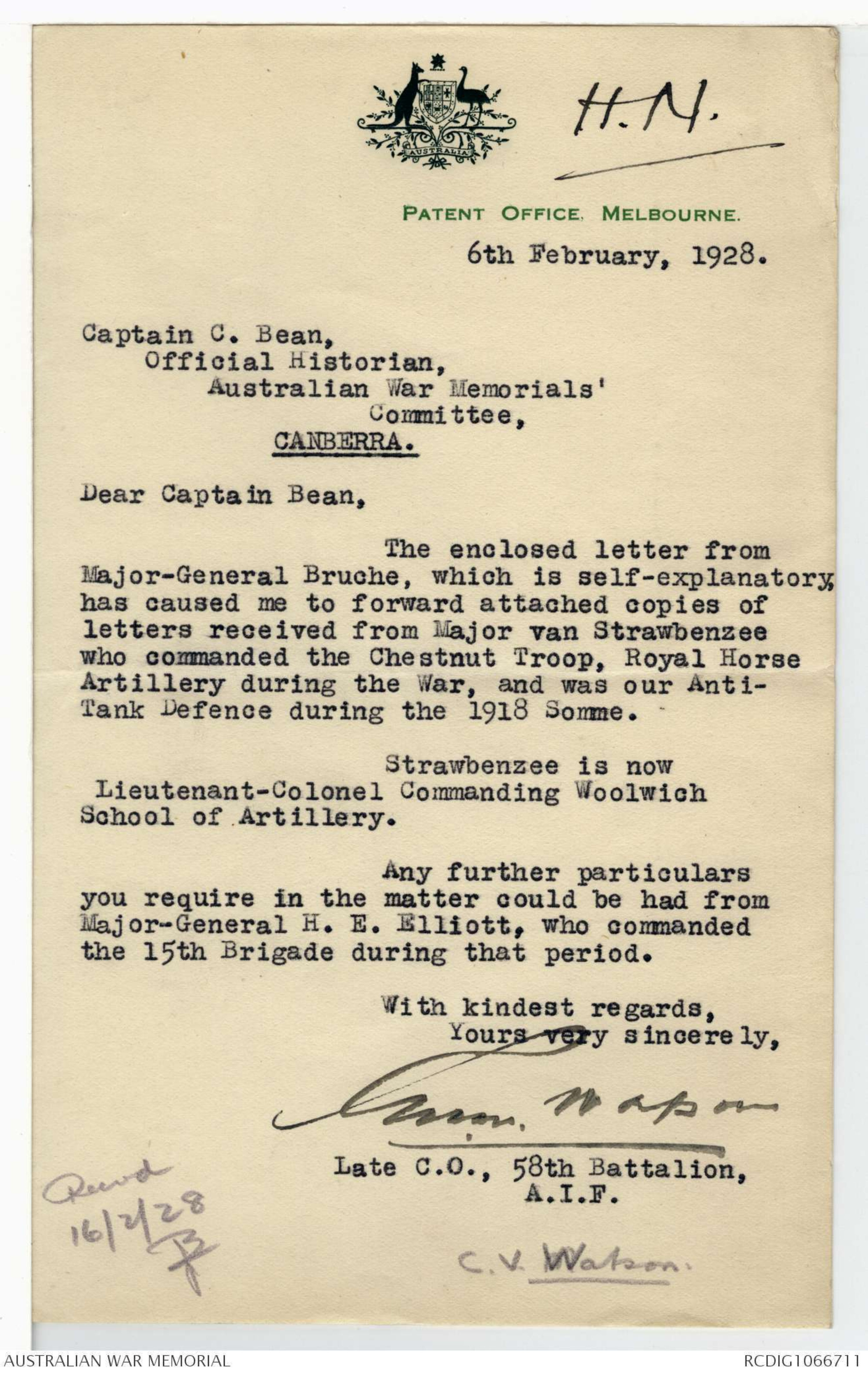
- 2 -
You might be able to put a few questions to me on the foregoing
whereby I can give you further assistance.
(sgd.) N. G. Halton
Hand drawn diagram – see original
This is a rough reproduction
of the sketch he added to his
report and if drawn from memory
it is a jolly good picture.
Note 'A'.
Halton was not aware at the time that counter-attack was
made on 24 4/18 that the unit on our right (7th Bedfords) did not
have to face due east on attaining their objection. I was not aware
either when I received Bde operation orders that the right flank (British)
Brigade was only required to reach an objective situated more or less on the
line held prior to German attack on 24 April. We went in to the attack
believing that the units on our right would also be required to face East when they
consolidated. Halton, of course, had not seen the Brigade operation order nor
was he present when I gave attack orders to Coy Commanders. His O.C. (Captain
Wilmot) was killed early in the fight so Halton faced the morning light on 25 April
believing that our objective (& that of the British battalion on his right) was on a North
& South line facing East. Actually our objective (13th Bn) ran from U 6 C 5.3
and East to U 6 d 4.3 (along line of CACHY - MARCELCAVE Road thence N.E.
through V 1 a and b to P. 31 d 6.7. (approx) where our flank with 15 Inf
Bde was to join. I was unaware then that where the original British front
line ran line ^xxx prior to German attack on 24th April except on that portion of the objective
allotted to 13th Aus Inf Bde but thought it coincided with the line of the road
from Monument Wood to Hangard Wood. (U 6 C 5.3.) through U 11 b and d.
Thus I was in extreme doubt on morning of 25 April of the position of the British on
our right & also where the enemy was xx until I saw the result of the Whippet Tanks
"reconnaissance" that afternoon). I had no doubt then! RW
[*I mentioned these matters (re British composite brigade on our right flank) and also the
affair of the Whippet Tanks in the report or comments that I sent you a couple of years
ago when you sent me a draft copy of the British Official History. RW
17 7/35
HN: V/B.
Nicholas (52 Bn)
2 Richardson Terrace
Daglish
W.A
Dr C E W Bean
Victoria Barracks
Paddington
NSW.
Dear Sir
I understand that you
are seeking information for the
purpose of writing up the record
of Villers- Bretonneux.
I was one of the original members
of the 52 Btn which was formed in
Egypt and I held the rank of
platoon Sergeant with the Btn in
France. I am giving you a
brief version of my experience at
V-B which may be of use to you
Yours faithfully
Sgt A. Nicholas
H.N. V/B. 51 Bn. Nicholas
Page I
Villers - Bretonneux
We were out on our usual parade, in one of the
French fields, when a brigade runner came up to
our commander with a message, the time being
about 11 o'clock. The captain instantly gave the
order to return to our billets, and get into fighting
order. We were ready to leave about 11.30 and though
the cooks reported that dinner was ready, we were
not allowed to remain and eat it. As we marched
along, we helped ourselves to the rations we had
in our haversacks. We were naturally anxious to
know what was doing, but could get no news from
our officers. However we got some information along
the route that Fritz had broken through the
Tommies' line.
It was a dull sort of day, with clouds flying very
low, and while going across some fields towards the
line, a German plane flew down from the clouds, just
over our heads, so evidently they expected an attack.
We marched all the afternoon, and it was not
until six o'clock that we halted, still waiting
for news. About seven o'clock our Battalion Commander
Captain Kennedy called the N.C.Os together and informed
us that we were to hop over at eight o'clock that
evening. He could not give us any information regarding
the lay of the country, or what opposition we
were likely to meet. This is the way he spoke,
"you have got to advance 3,000 yards in a North-
Page II
easterly direction, you have got to get there and
get there an the best way you can. If I remember
correctly, the village was on our left. Our battalion
was instructed to advance in two lines, allowing
about 150 yards between the lines. There were two
companies in the first line and two in the
second line. I was in C. company which was
in the second line. The orders were for the
first line to go right through, and the second
line was to mop up all the prisoners and
send them back. We knew there was
but little danger from gas attacks, as the
wind was blowing from behind us. There
was not much shell fire in our sector, not
the nerve-wrecking barrages of Pozieres and
Moquet Farm, but we soon got into a barrage
of of machine gun fire.
It was rather a foggy night and illuminations
by the verey lights sent over by the Germans
were simply wonderful. The machine guns soon
told on our lines, and we could see the lines
thinning out. How anyone could have advanced
under such conditions was a mystery, as there
was a continual firing of bullets whizzing past,
A remarkable incident happened during the
attack. We noticed phosphorous bullets being
fired out of a dug-out immediately in front.
Page [[III?]]
They were firing at the first line which
had just gone through. The voice of Lieutenant
Rogers, our platoon officer still rings in my
ears, when he yelled, "There they are boys, get
them!" Needless to say they did not fire any
more bullets, and our attitude towards the German
prisoners changed very much after that little
affair. The front line was thinning out, and
we gradually got in line with them. When we
had advanced about two thousand yards the
line stopped. I cannot give any reason for it.
I only had about half a dozen men left of my
own platoon, though the line was fairly strong.
It was composed mainly of men from other
companies and battalions. I immediately endeavoured
to get in touch with some of our officers, but
could not locate any. In walking along the
line inquiring if there were any Australian
officers about, I was halted by a young English
officer wearing a gas mask. He asked me who I
was at the same time covering me with a
revolver. He asked me it the smoke that was
coming from some German shells fired to the
rear of us was gas. My reply was. "If this is
gas I would have been dead long ago. He then
ordered his party of about two or three dozen
men from some of the Midland Counties regiment
Page IV
to take off their gas masks. I could get no
information from him regarding our position.
I travelled further south, and after going a
little distance I noticed a crowd retiring.
Thinking that a German spy might have
given the order I ran back and found out
it was the same English officer taking his
men to some comfortable dug-outs further back.
I ordered them back, to the front line, which
they obeyed. Still failing to receive instructions
as to what to do, I decided to make for the
village, but on my way there I received a
bullet wound in the left arm.
After wishing luck to the few that was
left in the platoon, I got hold of some German
prisoners, who were straying about, and took
them back with me. This ends my story.
C/O Agricultural Bank,
BRUCE ROCK W.A.
11th July 1935
Dr Bean,
Victoria Barracks,
PADDINGTON
N.S.W.
Dear Sir,
I notice by a paragraph in the local press
that you would like ex-members of the 51st and 52nd
Battalions to write to you of their experiences at
Villers Bretonneux. You will probably not receive
many accounts from ex West Australian 52nd Battalion
men, as I believe there would not have been more than
one hundred of such left in the Battalion when the
battle was fought. I am therefore sending you an
account of my experiences, though I am afraid they
are of too trivial a nature to be of very much use to
you.
I was an actual eye-witness to the death
of Baron Richthofen, the German ace, and as there
has since been much controversy upon his death, I am
penning you my version in the hope it may be of use to you.
Yours faithfully,
AE Maclean
REG. NO. 3383 52nd BATTALION
(H.O. SCOUT SECTION)
Encl.
52nd BATTALION AT VILLERS BRETONNEUX
The battalion had moved back from Vaux Sur Somme on
22nd April 1918 to Point Noyells. On the night of the
23rd April a very heavy bombardment could be plainly
heard which was rightly guessed as a forerunner of another
German attack. In the morning, orders came through that
the battalion was to move at once.
The writer, who was attached to the battalion scounts,
was ordered with his section to report for duty without
being given time for breakfast, though it was ready and
would not have taken more than a few minutes. A small thing
in itself, but an augury that things were not too well in
the line.
If I remember rightly, the section was to act as guides,
but after proceeding to a spot 5 or 6 miles of Villers
Bretonneux, we were joined by the best of the Battalion.
There was a heavy fog similar to that on the morning
when the Germans smashed through the 5th Army: because of
this it was not possible to see much of the country through
which we were passing. The Battalion was halted and rested
some time. While thus halted, a German plane flew up and
down the lines at a very low altitude, gathering information.
An eighteen pounder nearby, opened fire, but without success,
most of the shells bursting above the plane. To overcome
this, they tried bursting a shell just beyond the muzzle
of the gun but the Aviator must have seen the gun in time
and turned aside, disappearing into the mist with the information
he had gathered. He was a brave man but as we knew
that his information was for the enemy's Head Quarters, we
saw his going with regret.
The Battalion moved up South of the Bois L'Abbe to its objective
to the South West of Villers Bretonneux with the remnants
of the "Tommy" troops, whose job it was to clear the
wood on their left. Battalion Head Quarters were there of
course, to the rear of the Companies, and I did not actually
see the attack which if I remember rightly, was at nightfall
contrary to the Usual British practise of attacking at dawn.
The position was very obscure for a long time and Battalion
Head Quarters had some difficulty in locating the exact
whereabouts of the Companies. Some of the original "Tommy"
defenders were holding isolated posts when our fellows arrived.
I was told that some of these opened fire and killed some of
the 51st Battalion under the mistaken impression that it was
another German attack.
During the advance, the shelling was heavy, but afterwards
was not specially in evidence.
I believe there was somewhat of a gap between the 52nd
Battalion and the French on our left, and from my observations
at the time, one of our whippet tanks made an incursion into
No-Man's-Land to inspect the German trench much to the alarm
of its occupants, who opened heavy rifle fire and sent up
many flares: however as it was about midday when the incident
took place, the flares did not show up in the sunlight and
the German artillery could not have picked them up, as there
was no answering barrage. The German Soldiers could plainly
be seen and were in force shoulder to shoulder, which made
it appear that they had contemplated a counter attach; this
probably owing to the inquisitiveness of the tank, they however
did not evacuate eventuate. The tank, after its inspection, returned to
our lines without worrying about returning the German fire.
2.
The writer was chiefly engaged in guiding up
ration parties and taking messages back during the Battalion's
stay in the lien.
The Battalion was relieved on the 26th April
moving back to Blange Trouville. Part of our line was taken
over by French Troops clad in green uniforms instead of the
customary sky-blue: these consisted, I believe, of Zouaves,
Foreign Legion, and Russians serving with the French. It
was noticeable that the Zouaves dug in all over the place
and seemed to have an aversion to occupying a continuous
trench.
The 52nd moved to Bois L'Abbee on 27th April and
into Villers Bretonneux on the 9th May. On the 10th May
the writer was evacuated with Trench fever. I believe the
front was held by one man every 12 yards - a magnificent
bluff: had Fritz attacked, he could not have helped going
through.
It was the last appearance of the Battalion as a
unit of the A.I.F. As you know, there were not sufficient
reinforcements to build up the Battalion's wastages and extinction
followed. It still leaves a bitter taste to this
day.
The writer was transferred to the 51st and soon
afterwards to the "Cadre" in England.
JSMaclean
AUSTRALIA
H.N.
PATENT OFFICE, MELBOURNE
6th February, 1928.
Captain C. Bean,
Official Historian, Australian War Memorials'
Committee,
CANBERRA.
Dear Captain Bean,
The enclosed letter from
Major-General Bruche, which is self-explanatory,
has caused me to forward attached copies of
letters received from Major van Strawbenzee
who commanded the Chestnut Troops, Royal Horse
Artillery during the War, and was our Anti-
Tank Defence during the 1918 Somme.
Strawbenzee is now
Lieutenant-Colonel Commanding Woolwich
School of Artillery.
Any further particulars
you require in the matter could be had from
Major-General H. E. Elliott, who commanded
the 15th Brigade during that period.
With kindest regards,
Yours very sincerely,
Charles Watson
Late C.O., 58th Battalion,
A.I.F.
C.V. Watson
[*Recvd
16/2/28
B*]
 Sam scott
Sam scottThis transcription item is now locked to you for editing. To release the lock either Save your changes or Cancel.
This lock will be automatically released after 60 minutes of inactivity.